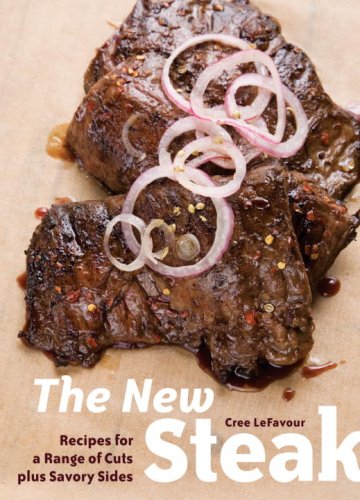
The New Steak: Recipes for a Range of Cuts plus Savory Sides
Web Watch has a friend who claims to be a “new-fangled vegetarian”: they will only eat vegetables after they’ve been processed by a cow.
Yes, nothing beats a good piece of steak that’s been rubbed and marinated just right and cooked on a hot grill on a summer day when there’s cold beer to be had for the grillmaster.
So let’s talk a little bit about the type of meat that you’ll want to serve up next weekend. First, you need to decide what type of meat you want to put onto the grill. You can always take a cue from the CATTLEMEN’S BEEF BOARD about what they’re saying are the TOP TEN SELLING CUTS OF BEEF for this grilling season.
- Boneless Ribeye
- Boneless Top Sirloin
- New York Strip
- T-Bone
- Bone-in Ribeye
- Bone-in New York Strip
- Bone-in Porterhouse
- Filet Mignon
- Boneless Tri Tip
- Boneless Chuck Eye Steak
The next question you should ask is what level of beef should you be purchasing? If you’re into making big food purchases and then storing meat in your freezer properly protected against the dreaded freezer burn, then you probably purchase your meat at a big warehouse store like Sam’s Club or Costco.
A sidenote: Food Network’s Alton Brown does not believe in freezer bags for his frozen steaks, preferring to individually double-wrap steaks in plastic wrap, then overwrapping them with heavy duty aluminum foil.
If you’ve been to your local Sam’s or Costco, you may have noticed that SAM’S CLUB SELLS “CHOICE” CUTS, WHILE COSTCO ALSO OCCASIONALLY SELLS “PRIME” CUTS. And since you already know that “prime” is better than “choice”, the question comes down to whether the extra per-pound cost of a “prime” steak is worth it or not.
Without even cooking and eating the food, Web Watch will just point out that when you go to one of those fancy steakhouses – you’re most likely getting USDA Prime, not USDA Choice. That’s part of the reason why those fancy steakhouses are more expensive than that place just down the street with the neon and drive-thru window.
Or, if you look at it in a more practical manner, do your own cost comparison between Prime and Choice. In 2006, for example, there was just a 23% difference in price between the two grades. Definitely worth the effort to upgrade. The 62% upgrade on a NY Strip steak might take a little bit more negotiation.
Another word of advice, regardless of which level of meat you purchase – be sure that if you go with “choice” or “prime” that the meat is labeled as “USDA Choice” or “USDA Prime” instead of without the “USDA” part. Some stores may simply say “Prime” or “Choice” as an advertising gimmick rather than selling you what you’re expecting to get.
And stay away from “Select” graded steaks if you’re looking to impress your boss at the next dinner party. Keep those for your own family meals.
